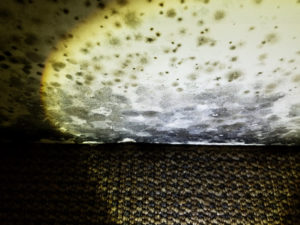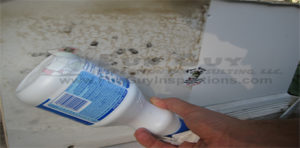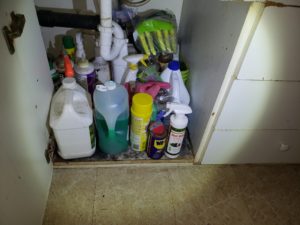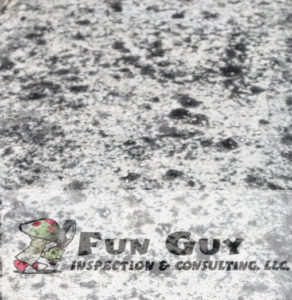
Does bleach clean mold? If not, what can I use?
Basic Information about Mold:
Mold is a type of fungi that appears like a plant, but it is neither a plant nor an animal. Unlike animals, it doesn’t require
food to live, plus it cannot produce its food like plants. It requires basic needs to survive, such as warm temperature, a food source, and water. A suitable environment is necessary for its reproduction. For searching for an appropriate environment, it regularly sends microscopic spores into the air. Once it gets a perfect environment, it begins to grow fast, sometimes within 24 hours. That’s why we often see mold blooming after water damage, flooding, and burst pipes.
Does bleach clean mold? Different bleach brands introduced their products and promised you that these bleaches could do the job of disinfecting the mold. Chlorine bleach is the best perspective for cleaning, but that doesn’t mean it is the best option to get rid of mold. It is not environment friendly and not very safe to use. It is efficient for non-porous surfaces, but it causes serious health problems.
How to use bleach on the non-porous surface to remove mold:
Bleach can’t kill the mold effectively on a porous surface, but it can eliminate mold from a non-porous surface. For doing the job well, you should follow the steps:
- Open the windows and doors and turn on the fan to let out the foul air of the room.
- Complete the safety measure for you. Wear gloves, eye goggles, masks, and old clothes to protect your body from toxic chemicals.
- Make a solution by mixing one cup of bleach into one gallon of water.
- Pour the mixture into a spray bottle.
- Spray directly onto the mold and scrub the surface with a stiff brush.
- Rinse out the surface with fresh water and let the surface to be dry.
- After completing the steps, throw away the clothes.
It may be useful in some applications, but it
can cause some problems. These problems are described below as:

Bleach kills mold on non-porous surfaces, and it is not designed for porous surfaces.
You can use the bleach for hard and non-porous surfaces like glass or tile. It means the scope of bleach is limited to a non-porous surface. In order to survive, mold spores spread its root into a porous surface such as wood and drywall. Mold remedy requires a cleaner that goes deep down into the material to put out the origins of the mold. The bleach only kills the mold on the outside surface, but the internal mold always grows up. The bleach is not designed to go inside the porous surface and kills the mold inside. When you apply chlorine bleach, it disinfects the mold for a week or two, and after some time, the mold returns with worse.
Bleach is a solution of chlorine and 90% of water. As we’ve discussed, the mold loves water, which means that when you apply bleach, the chlorine quickly evaporates and leaves a lot of water. This water soaks into the porous surface that makes such a moist environment that is best for mold growth. So, using bleach gives increase to mold rather than disinfecting it.
Bleach is toxic
Chlorine bleach produces air pollutants like fumes. These pollutants are harmful to humans and pets. The use of chlorine bleaches results in the evolution of a by-product called dioxin, which can lead to cancer. Also, bleach may react with other acids and drain cleaners that result in the release of chlorine gas. Inhaling the gas may cause breathing problems, a runny nose, and watery eyes. When we inhale chlorine gas in large amount, it can cause:
- Pneumonia
- Vomiting
- Chest pain
- Severe breathing problem
- Fluid in lungs
While bleaching, if it drops a little on your skin, it will damage your skin. Be careful and use safety measures (Wear gloves, eyeglasses, masks, and old clothes) while using bleach. So, you can imagine how toxic it can be to use bleach.
Bleach loses effectiveness over time.
Using older bleach would not kill the mold effectively. The reason behind this is, chlorine evaporates as time passes, and the solution does not have enough chlorine to disinfect the mold. The older bleach only kills the surface mold, which means it will create a mold with worse. There are many other non-toxic alternatives to get rid of the mold on both porous and non-porous surfaces.
So, what should you use to kill mold?
Determine whether you should clean up the mold yourself or hire a professional. Always choose wisely after doing complete research. If you have decided to kill the mold by yourself, then many methods are waiting for you to try them all. The most important thing you have to consider is whether the surface is porous or non-porous, then choose your perspective accordingly. Check out the cause of the moisture and fix it. Cut out the moldy material from its roots by using some methods that are discussed in detail below. It will make sure the mold will not come again.
Some people use borax, hydrogen peroxide, tea tree oil, ammonia, and vinegar to kill the mold. A detailed note is written on solutions that include their pros and con and how to use them all. All of these solutions are great non-toxic alternatives to chemical cleaners like bleach and ammonia. These products not only safe to use, but also all of these products are readily available in local stores at a meager price.
 Mold Removal with Borax
Mold Removal with Borax
Borax is a natural cleaning product, and it is not toxic until you swallow it. It is also known as a natural mold inhibitor. It doesn’t emit toxic fumes and chemicals like some other mold cleaners. It is a white mineral powder that has a pH of 9. It can also be used as a toilet cleaner, fungicide, herbicide, and insecticide. A solution of water and borax powder is used to remove and kill the mold. It is available in supermarkets for a few dollars.
How to Kill Mold with Borax
- Make a solution by mixing one cup of borax in one-gallon water
- During the cleaning process, clean up the loose mold to lessen the number of spores.
- Apply a borax-water solution and use a scrub brush to scrub the mold off the surface.
- Once the surface is dried, wipe up extra moisture from the surface to prevent mold growth.
- There is no need to rinse out the surface because it will prevent the surface from mold growth again.
- Leave the surface to dry.
Mold Removal with Vinegar
Vinegar is a safe and natural mild acid that can remove 82% of mold species. It is also non-toxic and doesn’t generate dangerous fumes and chemicals. Baking soda can also be used along with vinegar to remove different mold species.
How to Kill Mold with Vinegar
White distilled vinegar is easily available in the supermarket that is effective to kill mold. Following steps you should follow:
- Pour pure vinegar into a spray bottle without adding water to it.
- Simply spray on the mold and leave the surface for an hour.
- Rinse the surface with warm water and let the surface dry naturally. Wipe up the extra moisture after rinsing out. If you feel some vinegar smell, then no need to worry, it will disappear after a few hours.
If you want to prevent the surface from mold growing, just spray the vinegar on the surface and leave it. Repeat the process for the next few days to make sure the entire mold has been killed. If you’re worried about mold growing on tiled floors and non-porous floors, you can clean them with vinegar.
Mold Removal with Ammonia
Like bleach, ammonia also does the job well on hard non-porous surfaces (Glass and tiles), and it is ineffective for killing the mold on the porous surface (wood and drywall).
Moreover, it is a toxic chemical, just like bleach. Never mix chlorine bleach with ammonia because both create very toxic gas after mixing. A mixture of chlorine and ammonia gas was used as a chemical weapon during World War 2. So, you can imagine how poisonous and dangerous it is.
Ammonia can kill the surface mold and its spores for some time. You will need to remove them afterward. If you want to kill the mold effectively, then you need to attack the mold’s root, but ammonia is not the best.
How to Kill Mold with Ammonia
- Be sure never to mix ammonia with bleach.
- Create a solution of 50% clear ammonia and 50% water, pour it into a spray bottle and spray it on the moldy surface.
- Ensure safety measures before applying the solution.
- After spraying, leave the surface for a few hours.
- After a few hours, rinse the surface with clear water and wipe out the moisture after dry.
- Mold cleaning products and detergents contain ammonia. If you’re using those products, you should follow the instructions on the label.
Mold Removal with Hydrogen Peroxide
Hydrogen peroxide is a combination of hydrogen and oxygen. It is antibacterial, antifungal, and anti-viral, which means it kills viruses and bacteria. It can be used as an alternative to chlorine bleach. It is safe to use and not very toxic because it doesn’t generate fumes and chemicals. It is safe for the environment. This solution is available at drug stores for only one dollar.
Hydrogen peroxide reacts rapidly by releasing oxygen. This reaction, in return, decomposes the surface of the mold and cleans the mold. It cleans the mold efficiently from floors, clothes, walls, bathroom fixtures, and kitchen appliances. Since it is a bleaching agent, it can fade the surface’s color. So make sure before applying on the surface that it won’t fade the color.
 How to Kill Mold with Hydrogen Peroxide
How to Kill Mold with Hydrogen Peroxide
- Pour a 3% concentration of hydrogen peroxide into a spray bottle.
- Spray it on the moldy areas
- Leave the surface for more than 10 minutes.
- After ten minutes, scrub the surface to remove the entire mold and mold stains.
- Finally, wipe the surface to remove the rest of the mold, moisture, and mold spores.
For having a better result, you can make a mixture of vinegar with hydrogen peroxide. It will kill the mold faster and effectively. Store the rest of the solution in dark places since light makes the hydrogen peroxide inefficient.
Mold Removal with Detergent and Water
A solution of detergent and warm water is designed to kill the mold from the non-porous material. If the mold is on the non-porous surface where it can’t spread its roots, the detergent will clean away the entire mold on the surface. You can use it for cleaning purposes daily. You can buy it from any market.
How to Kill Mold with Detergent and water
- Apply the solution on the non-porous surface.
- Leave the surface to sit for 10 minutes while the detergent cleans the mold.
- Use a scrub brush to make the surface mold-free.
- Rinse the surface with warm water and let it dry.
Mold Removal with Baking Soda.
Baking soda is the safest household cleaner. The pH of baking soda is 8.1, which means it is harmless to humans and pets. It doesn’t produce toxic chemicals and gases as bleach does.
Are you worried about the mold smell? Baking soda not only kills the mold, but it also removes the smell of mold after cleaning. Also, you need nothing to do to absorb the moisture because baking soda does this very well and keeps the mold away. You can also use a solution of vinegar and baking soda for killing different species of mold.
[wpforms id=”52″]
How to Kill Mold with Baking Soda
- Add one-quarter of a tablespoon of baking soda into water and pour the mi
xture into a bottle  Spray the solution on the moldy surfaces.
Spray the solution on the moldy surfaces.- Then use a scrubbing brush to remove mold spores from the surface.
- After this, rinse the surface with water to clean the rest of the mold.
- Again spray on the surface and let the surface dry. It will prevent mold from returning.
You can use a cloth to scrub the surface and instead of a spray bottle:
- Soak the cloth in the liquid and rub the cloth on the surface to remove mold.
- Make a solution of baking soda and water.
- Mold Removal with Tea Tree Oil
If you are looking for quick removal of mold from a ceiling, curtain, then tea tree oil is the most effective natural mold killing solution from all other solutions. However, it is expensive, but its small quantity is enough to put out the mold from its roots. It is an antifungal and antibacterial solution that kills all the type of mold. It is environmentally friendly and safe to use. It can be toxic if swallowed and cause skin damage. So, use hand gloves and keep it away from your mouth.
Tea Tree oil is harmless to your family and animals. It seems to kill every type of mold. Its small bottle is available on all-natural food stores for about 10$. Make sure to buy tea tree oil that is derived from Melaleuca Alternifolia, which is not a brand name but a scientific name for tea tree.
How to Kill Mold with Tea Tree Oil
- Fill the spray bottle with water and count how many cups it takes to fill.
- Add one teaspoon of tea tree oil per cup of water. Shake the solution before use.
- Spray the solution where mold is growing.
- Leave the surface without rinsing, because the presence of tea tree oil will kill the entire mold and prevent the surface from returning the mold.
You can also use a cloth with tea tree oil to clean away mold. Follow the steps:
- Make a solution of tea tree oil, as mentioned above.
- Soak the cloth into the solution and rub it onto the surface to kill the mold.
- Again, there is no need to rinse the surface.
You will feel some smell after using the oil, but don’t worry because it will go away after some time. You can store and use the solution for a long time after making it as tea tree oil does not lose its potency after some time.
Mold Removal with Grapefruit Seed Extract
The grapefruit seed extract is the natural way to get rid of mold. There is no major difference between grapefruit seed extract and tea tree oil. Both are effective natural mold remover, a bit expensive, and available on all health stores. The advantage of using grapefruit seed extract is that it has no foul smell. It contains citric acid that attacks and kills the mold. It is also similar to baking soda, in the sense that it will remove bad smells. You can keep and use it for longer, just like tea tree oil, because it does not lose its effectiveness.
How to Kill Mold with Grapefruit Seed Extract
- Create a solution in a spray bottle by adding ten drops of grapefruit seed extract in a cup of water.
- Shake the bottle and then spray the solution onto the moldy surface. Leave the surface for 5-10 minutes in order to clean the mold more effectively.
- There is no need to rinse the surface afterward even though you can wipe the surface with a clean cloth after some time. If you let the solution in contact with mold for a longer time, then it would kill the mold and its spores efficiently and prevent mold from returning.
- You can repeat the same process after some days if you’re afraid of returning mold again on the surface.
- . You can use a towel if you don’t have a spray bottle or a scrub brush. Soak the cloth into the solution and apply it to the effective area.
This solution can be used again and again for the longer-term because it will remain potent in the spray bottle.
Tips for mold prevention
As we have discussed in detail, all the solutions to remove the mold. Now we are going to discuss some effective ways to prevent mold from growing in your home. You should follow some preventive steps that are given below:
- Keep your home dry and clean, especially in places where water may be present such as the kitchen and bathrooms.
- Fix all the issues that are related to water like leaking roofs, valves, and wet basements.
- Use a dehumidifier or air condition to keep the humidity level below 50 percent.
- Moisture is the main cause of mold, so if you see any sign of moisture, then fix it quickly with proper ventilation.
- Avoid installing the carpets in the kitchen, bathroom, or other rooms where there is a possibility of wetting.
- Improve airflow in your home
- If mats and rugs become wet unintentionally, then dry them as soon as possible.
Mold is a serious problem that shouldn’t be taken lightly. You should hire professional mold remediation experts. If you are going to clean the mold yourself, then do proper research before choosing a chemical or solution to clean mold. In this article, we have tried to give each and everything about how to clean mold. Several solutions for different surfaces and how to use them all are mentioned above. Each solution is defined in an informative way that will help you to choose the best choice. Take care of safety measures while using any solution. Keep away the solution from your skin and eyes also from the reach of children. We’re hoping that this article would help you to win the fight against the mold.
[wpforms id=”52″]

